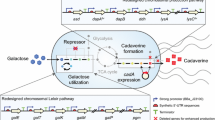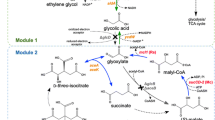Abstract
d-galactose is an attractive substrate for bioconversion. Herein, Escherichia coli was metabolically engineered to convert d-galactose into d-galactonate, a valuable compound in the polymer and cosmetic industries. d-galactonate productions by engineered E. coli strains were observed in shake flask cultivations containing 2 g L−1 d-galactose. Engineered E. coli expressing gld coding for galactose dehydrogenase from Pseudomonas syringae was able to produce 0.17 g L−1 d-galactonate. Inherent metabolic pathways for assimilating both d-galactose and d-galactonate were blocked to enhance the production of d-galactonate. This approach finally led to a 7.3-fold increase with d-galactonate concentration of 1.24 g L−1 and yield of 62.0 %. Batch fermentation in 20 g L−1 d-galactose of E. coli ∆galK∆dgoK mutant expressing the gld resulted in 17.6 g L−1 of d-galactonate accumulation and highest yield of 88.1 %. Metabolic engineering strategy developed in this study could be useful for industrial production of d-galactonate.





Similar content being viewed by others
References
Kim GS, Shin MK, Kim YJ, Kim YJ, Oh KK, Kim JS, Ryu HJ, Kim KH (2010) Method of producing biofuel using sea algae. US patent. Pub No. US 2010/0124774 A1, 20 May 2010
Kim NJ, Li H, Jung K, Chang HN, Lee PC (2011) Ethanol production from marine algal hydrolysates using Escherichia coli KO11. Bioresour Technol 102:7466–7469
Mittal N, Nisola GM, Chung WJ (2012) Facile catalytic dehydration of fructose to 5-hydroxymethylfurfural by niobium pentachloride. Tetrahedron Lett 53:3149–3155
Takagaki A, Nishimura S, Ebitani K (2012) Catalytic transformations of biomass-derived materials into value-added chemicals. Catal Surv Asia 16:164–182
Romero Zaliz CL, Varela O (2006) Facile synthesis of a d-galactono-1,6-lactone derivative, a precursor of a copolyester. Carbohydr Res 341:2973–2977
Yu RJ, Van Scott EJ (1997) Method of using galactonic acid or galactonolactone for treating wrinkles. US patent no. 5650436, 6 June 1995
Kusema BT, Murzin DY (2013) Catalytic oxidation of rare sugars over gold catalysts. Catal Sci Technol 3:297–307
Fiedler S, Buckel P (1990) The d-galactose dehydrogenase gene from Pseudomonas fluorescens: characterization of mutations leading to increased expression in Escherichia coli. Appl Microbiol Biotechnol 33:418–423
Holden HM, Rayment I, Thoden JB (2003) Structure and function of enzymes of the Leloir pathway for galactose metabolism. J Biol Chem 278:43885–43888
Cooper RA (1978) The utilization of d-galactonate and d-2-oxo-3-deoxygalactonate by Escherichia coli K-12. Arch Micrbiol 118:199–206
Wong TY, Yao X-T (1994) The DeLey-Doudoroff pathway of galactose metabolism in Azotobacter vinelandii. Appl Environ Microbiol 60:2065–2068
Kurn N, Contreras I, Shapiro L (1978) Galactose catabolism in Caulobacter crescentus. J Bacteriol 135:517–520
Maier E, Kurz G (1982) d-Galactose dehydrogenase from Pseudomonas fluorescens. Methods Enzymol 89:176–181
Yu C, Cao Y, Zou H, Xian M (2010) Metabolic engineering of Escherichia coli for biotechnological production of high-value organic acids and alcohols. Appl Microbiol Biotechnol 89:573–583
Baba T, Ara T, Hasegawa M, Takai Y, Okumura Y, Baba M, Datsenko KA, Tomita M, Wanner BL, Mori H (2006) Construction of Escherichia coli K-12 in-frame, single-gene knockout mutants: the Keio collection. Mol Syst Biol 2(2006):0008
Nanobio: Protocol for gene knockout (2009) http://openwetware.org/index.php?title=NanoBio:Protocol_for_gene_knockout&oldid=339609. Accessed 7 June 2010
Berghäll S, Hilditch S, Penttilä M, Richard P (2007) Identification in the mould Hypocrea jecorina of a gene encoding an NADP(+): d-xylose dehydrogenase. FEMS Microbiol Lett 277:249–253
Bradford MM (1976) A rapid and sensitive method for the quantitation of microgram quantities of protein utilizing the principle of protein-dye binding. Anal Biochem 72:248–254
Lien OG (1959) Determination of gluconolactone, galactonolactone, and their free acids by hydroxamate method. Anal Chem 31:1363–1366
Liu H, Valdehuesa KN, Nisola GM, Ramos KR, Chung WJ (2012) High yield production of d-xylonic acid from d-xylose using engineered Escherichia coli. Bioresour Technol 115:244–248
Buchert J, Viikari L, Linko M, Markkanen P (1986) Production of xylonic acid by Pseudomonas fragi. Biotechnol Lett 8:541–546
Pao SS, Paulsen IT, Saier MH Jr (1998) Major facilitator superfamily. Microbiol Mol Biol Rev 62:1–34
Puigbò P, Guzmán E, Romeu A, Garcia-Vallvé S (2007) OPTIMIZER: a web server for optimizing the codon usage of DNA sequences. Nucleic Acids Res 35:W126–W131
Zeng AP, Sabra W (2011) Microbial production of diols as platform chemicals: recent progresses. Curr Opin Biotechnol 22:749–757
Kuivanen J, Mojzita D, Wang Y, Hilditch S, Penttilä M, Richard P, Wiebe MG (2012) Engineering filamentous fungi for conversion of d-galacturonic acid to l-galactonic acid. Appl Environ Microbiol 78:8676–8683
Acknowledgments
This work was supported by Priority Research Centers Program through the National Research Foundation of Korea (NRF) funded by the Ministry of Education, Science and Technology (2012-0006693).
Author information
Authors and Affiliations
Corresponding author
Additional information
H. Liu, K. R. M. Ramos and K. N. G. Valdehuesa equally contributed to this work.
Electronic supplementary material
Below is the link to the electronic supplementary material.
Rights and permissions
About this article
Cite this article
Liu, H., Ramos, K.R.M., Valdehuesa, K.N.G. et al. Metabolic engineering of Escherichia coli for biosynthesis of d-galactonate. Bioprocess Biosyst Eng 37, 383–391 (2014). https://doi.org/10.1007/s00449-013-1003-6
Received:
Accepted:
Published:
Issue Date:
DOI: https://doi.org/10.1007/s00449-013-1003-6




